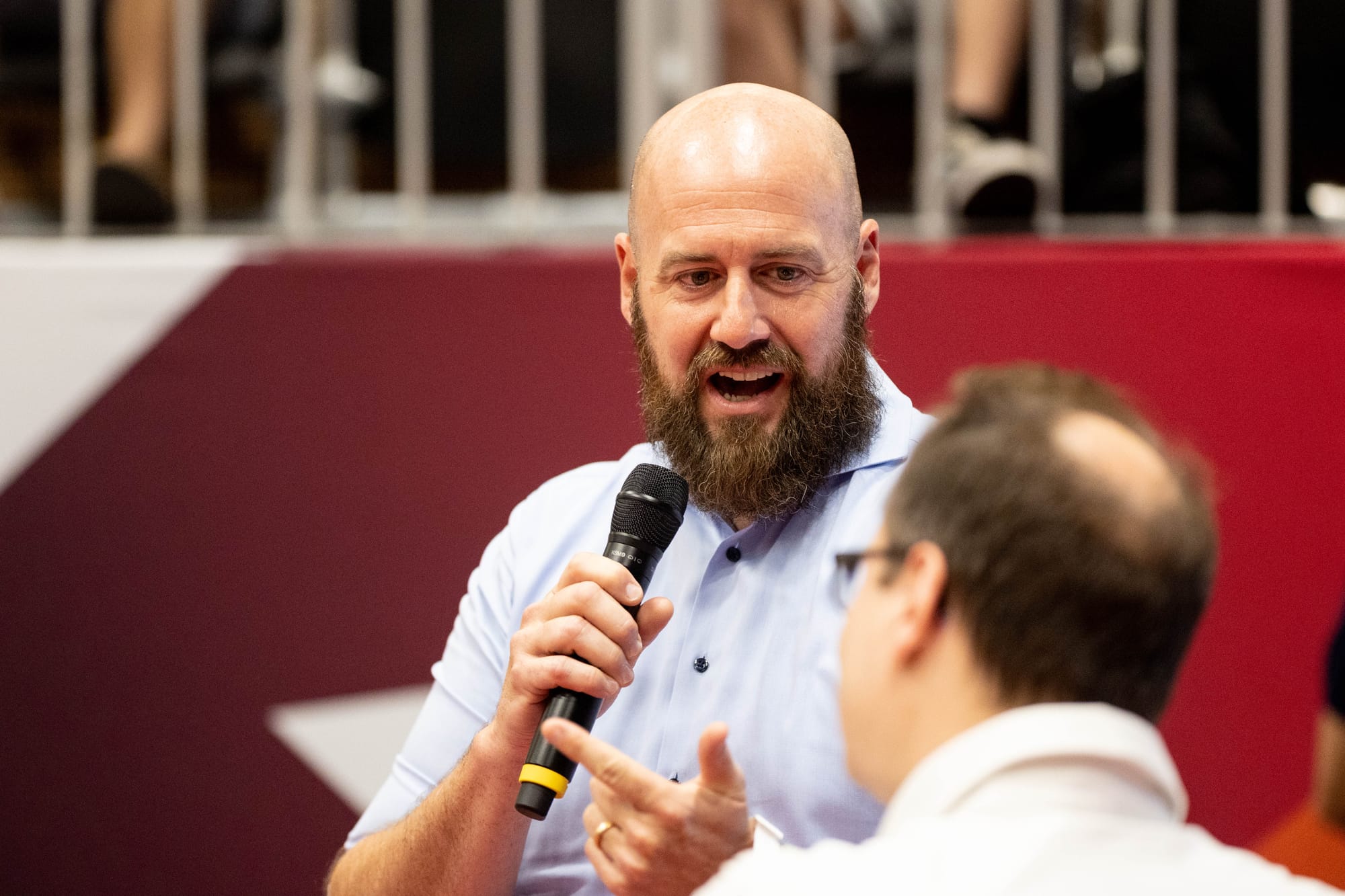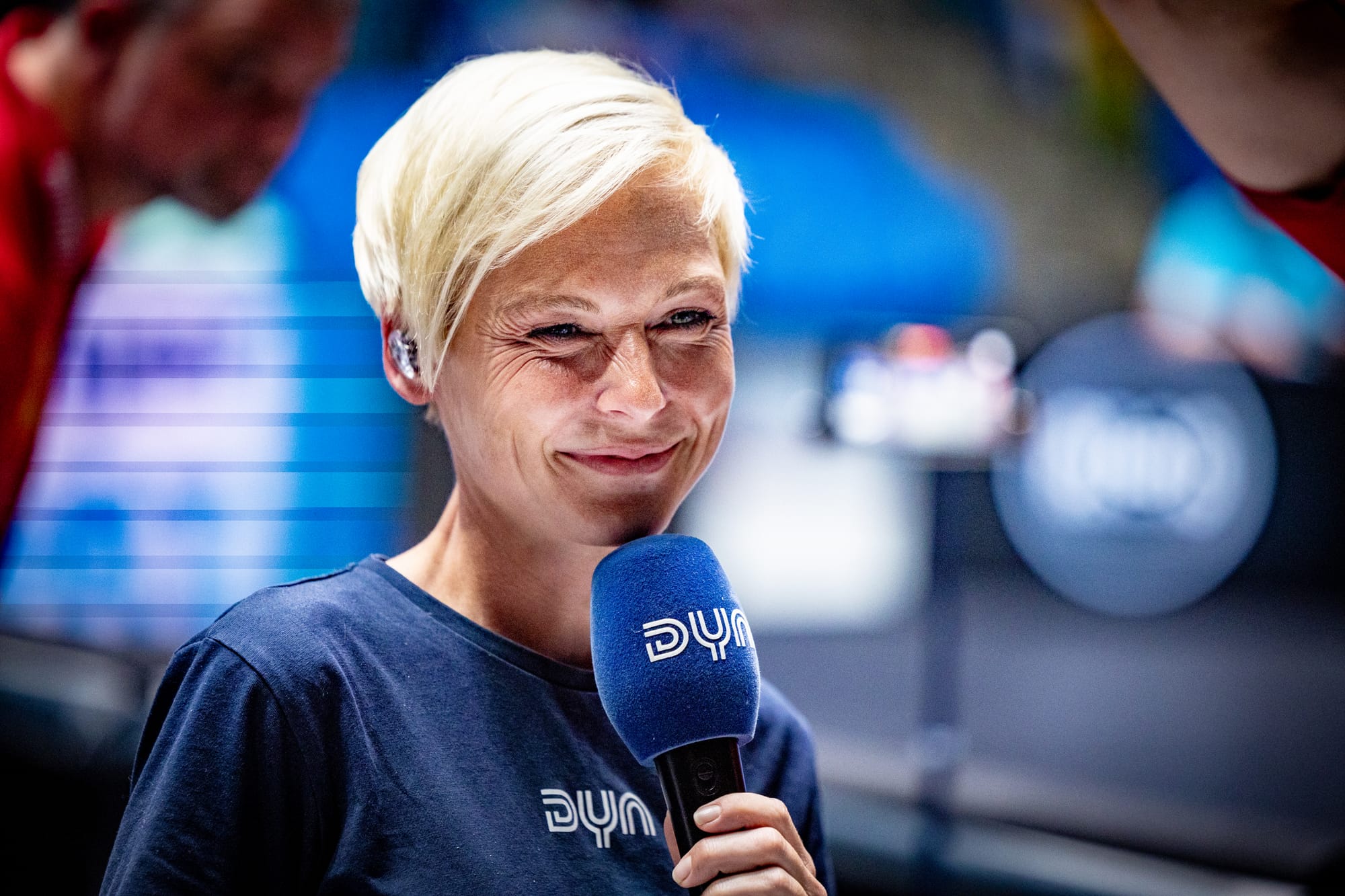Interview with Andreas Heyden (CEO Dyn Media): “We can only grow the community together”

Dyn looks back on the first year of its media partnership with the German Table Tennis League (TTBL). In an interview, Dyn CEO Andreas Heyden assesses the experiences of the innovative streaming provider in the past season and also provides initial insights into the plans for the coming season.
Andreas Heyden, the TTBL was the first addition to the new Dyn portfolio long before the start of broadcasting in summer 2023. Has the perception of sport in the house changed since then?
Dyn has a mission that goes beyond a singular perception of a sport. This means that we want to increase the perception and appreciation of our sports and promote their positive values in society with the help of fans. When we talk about “our sports”, we mean handball, basketball, volleyball, field hockey and, of course, table tennis. We have made the conscious decision to try to get many rights for our sports instead of many sports with few rights. As a result, we have acquired the two large TTBL and WTT rights packages in table tennis, around which we create a relatively large amount of editorial content. For me personally, table tennis is a super exciting sport, even if it is one of our smaller sports, because we show how a sport can be created in the media with innovative production and innovative storytelling. In terms of cooperation and the level of professionalization of the league and the clubs, what is being achieved there is absolutely remarkable, given the resources available.

All beginnings are difficult, and so Dyn was confronted with criticism during the season due to technical weaknesses in the stream and, not least, because of the paywall, which had long been unfamiliar in table tennis. How did your company overcome these adversities?
You have to separate two phases of learning. There was the time with Twitch, in which a free product with a low barrier to entry was provided and the clubs had time to learn how media production works. Not everything went perfectly during this time, but since we started broadcasting in August last year, external observers have also confirmed that we have had a good start overall. For example, we haven't had any total failures. Nevertheless, we learned a lot in the first few weeks and months. At the end of the season, however, and looking at the total number of matches broadcast, I think there were very few things that could really be criticized. But in general, we take all customer feedback seriously, and we also worked a lot on our site after we didn't cover all smart TV platforms behind the paywall at the start. However, we then activated new platforms every month, from AppleTV to FireTV. We also didn't have Paypal as a payment option at the beginning, which we were able to offer shortly after the launch. We also set up the entire platform from acquiring the rights to the launch.
Has the feedback from the community changed as a result of the improvements mentioned?
Between 93 and 96 percent of all customers were active in the last 30 days of the respective season. So we have created a product that people use and see. We also see a very moderate cancellation rate across all sports from one season to the next, and in table tennis in particular we are very satisfied. People, our subscribers, come often, watch a lot - and only a few cancel. These are the KPIs, the key performance indicators that I look at the most. Couldn't there be more customers? Of course. But we're not in a sprint, we're running a marathon where we've done the first season behind the paywall and we're happy with the ratio of viewers who previously watched live for free to those who now watch for a fee. We particularly like the fact that formats such as “Plattenupdate” or “360”, which we normally only do for handball and basketball and have used Timo Boll to provide an unusual look behind the scenes, have been well received. We generate up to 20 percent of our total reach with on-demand views, which we are very satisfied with. Because anything that gives viewers a reason to watch more often helps them to understand the value of their subscription even better and not cancel.
Has Dyn been able to get to know the table tennis spectator in his debut season?
I don't think we've gained any new insights. We knew and received confirmation that the table tennis community is somewhat older, more regional and oriented towards the TTBL clubs. The table tennis group is more in line with the social average, i.e. not only older, but also more male.
Have there already been any suggestions from your table tennis customers that you have implemented during the season?
Indeed. One of the proposals was to make more content available to clubs more quickly for their own channels, and now every club can also use our content platform to download its content, edit it further and use it on its social media channels, homepage or app, and in some cases also market it. This is a big change - and not just for table tennis - because previous rights holders were rather restrictive in this respect. However, we are only just starting to develop this market on two levels. On the one hand, with monetization through the pay model, which allows us to build up production capacities with which we can bring the sport to life in the media in the first place. And secondly, through the advertising revenue stream, where we give sponsors and partners greater visibility because the clubs can reuse the content on their own channels.

Has it become apparent whether table tennis fans are also interested in the other sports on offer at Dyn and, conversely, whether fans of other sports are suddenly also interested in table tennis?
Regional overlaps or local effects with clubs from other sports are largely non-existent. But in general, most fans primarily watch their sport - but they do so intensively and a lot.
What developments in and for table tennis have you noticed since you started broadcasting?
You can divide these developments into two areas. Firstly, in connection with our rights to WTT tournaments, it was something completely new for us to go into the halls with our familiar faces or to celebrate cup or championship finals in the media. This helps to put the sport in a brighter light. On the other hand, we see and get feedback from the clubs that children's and youth sport is quite well attended, that there aren't really any problems with young talent.
Is that the approach for your “Move your sport” program?
In fact, in addition to our commitment as a media partner, we want to make a targeted contribution in areas such as the development and stabilization of structures in the youth sector. To this end, we invest ten percent of our subscription income to support youth development concepts within our partner leagues, with each of our subscribers deciding on the allocation of their contribution to a sport.
In addition to your company, the sport of table tennis would therefore benefit in several ways from a growing number of Dyn subscribers with an affinity for table tennis. How do you intend to achieve this increase?
Our subscribers experience value from the product they pay for, it works on any device of their choice and they are entertained. If these factors are in order, then I only need one thing: more users. Of course, clubs, leagues, players and associations also need to ensure that more customers subscribe to Dyn table tennis. Because this increases media revenue and strengthens the promotion of young talent. At a certain point, we have also done our basic job: We broadcast, we report, we run the web and apps, but we can only manage the growth of the community all together. I see the greatest potential in cooperation with the clubs and leagues, and we will work on appropriate models for this, because table tennis is a highly competitive sport that is played by millions of people worldwide and not just in grammar schools in villages. We are still at a lower level in Germany, but it is one of the five sports we are betting on.

Who has achieved which goals in the partnership so far?
I haven't heard any complaints yet. I'm very satisfied with the first season in which we took the step from free TV to introducing the paywall. We have also generated many lessons for field hockey, which will be the next sport to go down this path. For example, pay TV also means better availability because we are represented on all smart TVs and there are mobile apps. The fact that we now also present a sport in all its breadth and depth on one platform is a great value for our customers. We also receive feedback from clubs and leagues that sponsor interest has increased noticeably. It should also not be underestimated that table tennis now has a TV brand with Dyn-Tischtennis, just as Sky has for soccer.
Has Dyn already been able to come closer to its declared goal of being the “Home of...”, i.e. practically the home for each of its sports, in its premiere year?
If you want to understand “Home of...” on an emotional level as meaning that I can find everything that interests me there, then the answer is a resounding yes. Apart from the TTBL and WTT, there is hardly anything in table tennis that you would have to miss, with a few exceptions. We have achieved our goal, but we have also managed to be available in the majority of households, so that the broadcasts with the help of the clubs are of an appropriately high quality - and yet we are still only at the beginning.
What significance will a continuation of the overall developments and processes described above have for Dyn in the coming season?
We will certainly take a big step forward in the next five years with one of the three sports volleyball, table tennis and field hockey. Whether this will be table tennis cannot be predicted at the moment. In two or even better three years, we will certainly be able to make an interim assessment.

Will the program content of Dyn-Tischtennis change for the new season?
We will continue to experiment. We will continue to try out content such as the “Tactics Board” and at the same time look at content in the “Plate Update”. After all, a break in the season is also there for analysis. I think we'll do more with exciting personalities from the sport and tell stories, and continue to professionalize ourselves together with the clubs in order to be able to deal with topics outside of the game. In my opinion, the next stage of growth will be to make the content outside of live broadcasts even bigger, more attractive, broader, more interactive and more social. To this end, we will also pursue “Move your sport” more intensively and thus show what we are doing for our mission described at the beginning to bring the positive values of sport to society. In any case, we are looking forward to the new season.
Thank you very much for the interview, Andreas Heyden.
Interview: Florian Manzke
Featured images: (Photos: BeLa Sportfoto)